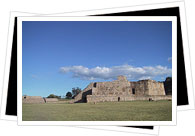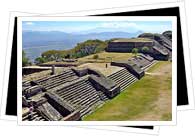One of the most spectacular pre-hispanic sites the world has to offer us, a visit to Oaxaca's Monte Albán will surely be one of the highlights of your trip to Oaxaca. Along with the historical centre of Oaxaca city, Monte Albán was declared a UNESCO World Heritage Site in 1987.

Where is it?
Located just 8km west from Oaxaca City, Monte Albán makes the perfect day trip plus it's quick, easy and cheap to get there. Tourist buses leave the city centre on an hourly basis between 8.30am and 3.30pm and you are then scheduled on a return bus a few hours later all for under $5. Alternatively a taxi should not cost more than $10 each way. The trip is a swifty 20 minute drive. If you fancy walking then make a day of it, take a picnic and prepare for some stunning vistas as you climb to the old city's entrance. By foot it will take around an hour and a half each way.
A little bit of History
Archeologists reckon that construction began on this incredible city around 200AD when Zapotec inhabitants set to work on buillding what would become their most important economic centre for many years. Whether it was lack of thought, or a desire to showoff their architectural skills, the Zapotecs chose this very impractical spot on which to build their city.
Dramatically poised 400m above the floor of the Valles Centrales, the Zapotecs had their work cut out with levelling the mountain top and carrying up materials to their chosen site. Whether or not they regretted their choice of location, what cannot be denied is that Monte Albán looks magnificent as it looms over the valleys below and dominates the skyline. Moreover, when you're actually up there you can enjoy some of the most impressive panoramic views of the surrounding areas - so it was definitely well worth all the pain and hard work. As more and more temples, plazas, palaces and patios were constructed, Monte Albán grew in prosperity, reaching its most powerful time between 300 and 700AD when up to 35,000 inhabitants resided in the majestic city centre and surrounding hillsides.

By 1000AD it had somewhat fallen from favour and after the arrival of the Mixtecs in the 13th century who continued to use the site, Monte Albán fell into decline. The Aztec invasion towards the end of the 15th century forced Monte Albán to be abandoned as things were operated from their own centre of Tecnochtitlán.
What is left today are the ruins of Monte Albán's old city centre as the buildings on the peripheries have mainly been destroyed. Whilst some bits are better preserved than others, the site is living proof of the sophistication and importance of pre-hispanic architecture. The frescoes and murals pay tribute to Zapotec culture and allow us to learn a lot about the customs and beliefs of this incredible civilization.
Monte Albán Highlights
- Los Danzantes - One of the most iconic parts of Oaxaca's Monte Albán, the carvings found at 'The Dancers' gallery and building have caught the interest of many archeologists. They consist of a series of nake figures depicting all kinds of things which some believe to be related to medical discovery - for example, childbirth, while others have suggested they are victims of sacrifice or just simply dancers. The faces of the figures are characteristic of Olmec style and debate has arisen as to whether they are infact Olmec, meaning they would have inhabited parts of Monte Albán first, or if they are Zapotec copies of traditional Olmec style.
- Plataforma Norte - Considered to have been the most important of Monte Albán's temples, a dramatic stone staircase leads up to an altar in a patio used for numerous ceremonial rites. Constructed between 400 and 700AD, this would have been one of the most majestic additions to the city when it was in its heyday.
- Tombs - 190 tombs have been excavated at Monte Albán and it is strongly believed that there are still many more waiting to be discovered. One of the most interesting is Tumba 7, originally Zapotec, the Mixtecs then used it for one of their own leaders, filling it with riches and jewels which can be admired at the Museo de las Culturas de Oaxaca (see Oaxaca Museums for more information). Tomb 105 is also highly rated for its Teotihucán influenced murals.
- Monticulo J - An interesting shaped structure built at a 45 degree angle to the things that surround it which has given rise to it being known as the Observatory. There are carved illustrations in relief on the side of the building which suggest the rising power of the Zapotec civilization as they captured more and more towns.
Monte Albán is open throughout the year between 8am and 6pm and there is small entrance fee.